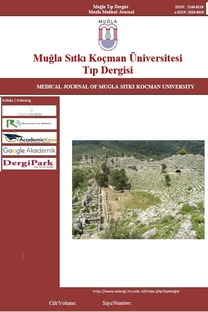Fibroadenomlara Yapılan Gereksiz Biyopsiler, Nasıl Oranlarını Düşürebiliriz?
Fibroadenoma, Meme, Tru-cut Biyopsi, Ultrasonografi
Unnecessary Biopsy For Fibroadenomas, How Can We Decrease Its Rate?
Fibroadenoma, Breast, Tru-cut Biopsy, Ultrasonography,
___
- 1. Houssami N, Cheung MN, Dixon JM. Fibroadenoma of the breast. Med J Aust. 2001;174:185-8.
- 2. Haagensen CD. Disease of the breast. 3rd ed. Philadelphia, Pa: W.B. Saunders; 1996. 267–83.
- 3. Rosai J. Breast, Chapter 20,Surgical Pathology ,Eighth Edition (ED:Rosai J) St. Louis :Mosby 1996,1565-60.
- 4. Prasad SN, Houserkova D. A comparison of mammography and ultrasonography in the evaluation of breast masses. Biomed Pap Med Fac Univ Palacky Olomouc Czech Repub. 2007;151:315-22.
- 5. Brinton LA, Vajsey MP, Flavel R. Risk factors for benign breast disease. Am J Epidemiol. 1981;113:203–14.
- 6. Yu H, Rohan TE, Cook MG, Howe GR. Risk factor for fibroadenoma: a case control study in Australia. Am J Epidemiol. 1992;135:247–58.
- 7. Funder Burk WW, Rosero E, Leffall LD. Breast lesions in blacks. Surg Gynecol Obstet. 1972;135:58–61.
- 8. Soini I, Aine R, Lauslthti K. Independent risk factor of benign and malignant breast lesion. Am J Epidemiol. 1981;114:507–14.
- 9. Ravnihar B, Segel DG, Lindther J. An epidemiologic study of breast cancer and benign breast neoplasm in relation to the oral contraceptive and estrogen use. Eur J Cancer. 1979;15:395–405.
- 10. Canny PF, Berkowitz GS, Kelsey JL. Fibroadenoma and the use of exogenous hormones: a case control study. Am J Epidemiol. 1988;127:454–61.
- 11. Dupont WD, Page DL, Park FF. Long-term risk for breast cancer in women with fibroadenoma. N Engl J Med. 1994;331:10–5.
- 12. Parazzini F, La Vecchia C, Franceshi S. Risk factors for pathologically confirmed benign breast disease. Am J Epidemiol. 1984;120:115–22.
- 13. Schuerch C, Rosen PP, Hirota T, et al. A pathologic study of benign breast diseases in Tokyo and New York. Cancer.1982;50:1899–903.
- 14. Amin AL, Purdy AC, Mattingly JD, Kong AL, Termuhlen PM. Benign breast disease. Surg Clin North Am. 2003;93(2): 299-308.
- 15. Rosen PP (ed.) Rosen’s breast pathology, 2nd edn. Philadelphia, PA: Lippincott Williams & Wilkins, 2001.
- 16. Dixon JM, Dobie V, Lamb J, Walsh JS, Chetty U. Assessment of the acceptability of conservative management of fibroadenoma of the breast. Br J Surg 1996;83:264–5.
- 17. Fornage BD, Lorigan JG, Andry E: Fibroadenoma of the breast: sonographic appearance. Radiology 1989;172:671–5.
- 18. D’Orsi CJ, Sickles EA, Mendelson EB, Morris EA: ACR BI-RADS® Atlas, Breast Imaging Reporting and Data System, ed 5. Reston, American College of Radiology, 2013.
- 19. Namazi A, Adibi A, Haghighi A, Hashemi M. An Evaluation of Ultrasound Features of Breast Fibroadenoma. Adv Biomed Res 2017;6:153.
- 20. Nishimura S, Matsusue S, Koizumi S, Kashihara S. Size of breast cancer on ultrasonography, cut-surface of resected specimen, and palpation. Ultrasound Med Biol. 1988; 14(suppl 1):139-42.
- 21. Cole-Beuglet C, Soriano RZ, Kurtz AB, Goldberg BB. Fibroadenoma of the breast: sonomammography correlated with pathology in 122 patients. AJR 1983;140(2):369-75.
- 22. Heywang SH, Lipsit ER, Glassman UM, Thomas MA. Specificity of ultrasonography in the diagnosis of benign breast masses. J Ultrasound Med. 1984;3:453-61.
- 23. Jackson VP, Rothschild PA, Kreipke DL, Mail JT, Holden RW. The spectrum of sonographic findings of fibroadenoma of the breast. Invest Radiol. 1986;21:34-40.
- 24. Powell DE, Stelling CB. Diagnosis and detection of breast diseases. St Louis, Mo: MosbyYear Book, 1992; 159-61.
- 25. Rosen PP. Breast pathology. Philadelphia, Pa: Lippincott-Raven, 1997; 143-75.
- 26. Lanyi M. Diagnosis and differential diagnosis of breast calcifications. New York, NY: Springer-Verlag, 1988; 145-56.
- 27. Sirous M, Shahnani PS, Sirous A. Investigation of Frequency Distribution of Breast Imaging Reporting and Data System (BIRADS) Classification and Epidemiological Factors Related to Breast Cancer in Iran: A 7-year Study (2010-2016). Adv Biomed Res. 2018;27;7:56.
- 28. Margaret ME, Chester HF, Stephen BE, Cathleen AC, Martin CM. BI-RADS Classification for Management of Abnormal Mammograms. FAAFP J Am Board Fam Med. 2006;19(2):161-4.
- 29. Malur S, Wurdinger S, Moritz A, Michels W, Schneider A. Comparison of written reports of mammography, sonography and magnetic resonance mammography for preoperative evaluation of breast lesions, with special emphasis on magnetic resonance mammography. Breast Cancer Res. 2001;3:55-60.
- 30. Devolli-Disha E, Manxhuka-Kërliu S, Ymeri H, Kutllovci A. Comparative accuracy of mammography and ultrasound in women with breast symptoms according to age and breast density. Bosn J Basic Med Sci. 2009;9:131-6.
- ISSN: 2148-8118
- Yayın Aralığı: 3
- Başlangıç: 2014
- Yayıncı: Muğla Sıtkı Koçman Üniversitesi
Ortopedik İmplant Enfeksiyonlarında İzole Edilen Bakteri Çeşitliliği ve Antibiyotik Duyarlılıkları
Emre GÜLTAÇ, Cem Yalın KILIINÇ, Ahmet Emrah AÇAN, Nevres Hürriyet AYDOĞAN
Müesser Özcan, Aslıhan Akpınar, Burak Çitil
Buerger Hastalığında Akut Ağrı Kontrolü için Periferik Sinir Bloğu: Vaka Serisi
Başak ALTIPARMAK, Ali İhsan UYSAL, Çiğdem GÜZEL, Cem Yalın KILINÇ, Ahmet İMERCİ, Semra GÜMÜŞ DEMİRBİLEK
Burak Can DEPBOYLU, Serkan YAZMAN, Kursad TOSUN
Fibroadenomlara Yapılan Gereksiz Biyopsiler, Nasıl Oranlarını Düşürebiliriz?
Emrah DOĞAN, Leyla TEKİN, Neşat ÇULLU, Murat POLAT
